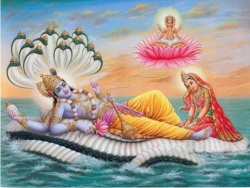Difference between revisions of "Nagas by Micha F. Lindemans"
m (Text replacement - "Category:Nāgas" to "Category:Nagas") |
m (1 revision: Adminos 18 sept 02.04AM) |
||
| (2 intermediate revisions by one other user not shown) | |||
| Line 1: | Line 1: | ||
[[File:AnanathaPadmanaban.jpg|thumb|250px|]] | [[File:AnanathaPadmanaban.jpg|thumb|250px|]] | ||
| − | + | In [[Hindu]] [[myth]], [[Nagas]] are a primeval race of [[divine]] serpent-people that play an important part in [[Religion]]. They are half [[human]] and half {{Wiki|snake}}, and are still worshipped as the bringers of {{Wiki|fertility}}, especially in southern [[India]]. [[Nagas]] are believed to [[live]] in {{Wiki|palaces}} ({{Wiki|Patala}}) in the underground city {{Wiki|Bhogavati}}. They are considered the [[Protectors]] of springs, wells and [[rivers]]. They bring [[rain]], and thus {{Wiki|fertility}}, but are also [[Thought]] to bring disasters such as floods and drought. Their ruler is [[Sesha]]. Some of the [[Nagas]] are: [[Ananta]] ([[Symbol]] of {{Wiki|eternity}}), [[Vasuki]], [[Manasa]] ({{Wiki|fertility}} [[goddess]] and protector against snake-bites), and [[Mucilinda]]. | |
| − | + | ||
| − | + | In the [[myths]] of Malay mariners, [[Nagas]] are a many-headed [[Dragons]] of enormous size. | |
| − | + | ||
| − | + | On {{Wiki|Java}} and [[Thailand]], a [[Naga]] is a [[mythical]] [[serpent]] or [[dragon]], a [[serpent]]-[[God]], a ruler of the netherworld who possesses immense [[Wealth]]. In {{Wiki|Java}} it is also called [[Sesa]]. In [[Thailand]], a [[Naga]] is often sculpted in [[temples]] as a [[dragon]] with five heads. It is the [[Symbol]] of [[Narayana]]. | |
| + | |||
{{R}} | {{R}} | ||
| − | [http://www.pantheon.org/articles/n/nagas.html] | + | [http://www.pantheon.org/articles/n/nagas.html pantheon.org] |
[[Category:Nagas]] | [[Category:Nagas]] | ||
[[Category:Buddhist Terms]] | [[Category:Buddhist Terms]] | ||
Latest revision as of 18:07, 17 September 2013
In Hindu myth, Nagas are a primeval race of divine serpent-people that play an important part in Religion. They are half human and half snake, and are still worshipped as the bringers of fertility, especially in southern India. Nagas are believed to live in palaces (Patala) in the underground city Bhogavati. They are considered the Protectors of springs, wells and rivers. They bring rain, and thus fertility, but are also Thought to bring disasters such as floods and drought. Their ruler is Sesha. Some of the Nagas are: Ananta (Symbol of eternity), Vasuki, Manasa (fertility goddess and protector against snake-bites), and Mucilinda.
In the myths of Malay mariners, Nagas are a many-headed Dragons of enormous size.
On Java and Thailand, a Naga is a mythical serpent or dragon, a serpent-God, a ruler of the netherworld who possesses immense Wealth. In Java it is also called Sesa. In Thailand, a Naga is often sculpted in temples as a dragon with five heads. It is the Symbol of Narayana.
